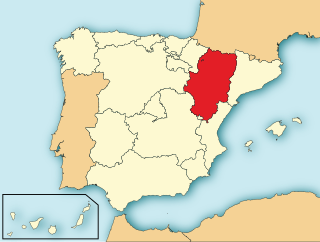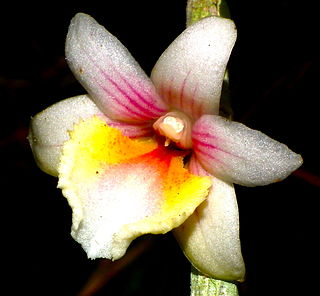| Hyocrinida | |
|---|---|
 | |
| Hyocrinus sp. | |
| Scientific classification | |
| Kingdom: | |
| Phylum: | |
| Class: | |
| Order: | Hyocrinida [1] |
| Synonyms [1] | |
Hyocrinina | |
Hyocrinida is an order of sea lilies which contains a single extant family, Hyocrinidae. [1]
| Hyocrinida | |
|---|---|
 | |
| Hyocrinus sp. | |
| Scientific classification | |
| Kingdom: | |
| Phylum: | |
| Class: | |
| Order: | Hyocrinida [1] |
| Synonyms [1] | |
Hyocrinina | |
Hyocrinida is an order of sea lilies which contains a single extant family, Hyocrinidae. [1]
Members of this order have long slender stems consisting of a large number of identical columnar units. There are no cirri, and the basal disc of the stem attaches directly to the substrate. The calyx is globular or conical, and consists of five widely-spaced, undivided arms attached to five radial ossicles. [2]

Most hyocrinids are found at depths below 700 m (2,300 ft), in the range 400 to 6,300 m (1,300 to 20,700 ft), in all the ocean basins and on seamounts. [2]


Crinoids are marine animals that make up the class Crinoidea. Crinoids that are attached to the sea bottom by a stalk in their adult form are commonly called sea lilies, while the unstalked forms, called feather stars or comatulids, are members of the largest crinoid order, Comatulida. Crinoids are echinoderms in the phylum Echinodermata, which also includes the starfish, brittle stars, sea urchins and sea cucumbers. They live in both shallow water and in depths as great as 9,000 meters (30,000 ft).

The Messerschmitt Me 264 was a long-range strategic bomber developed during World War II for the German Luftwaffe as its main strategic bomber. The design was later selected as Messerschmitt's competitor in the Reichsluftfahrtministerium's Amerikabomber programme, for a strategic bomber capable of attacking New York City from bases in France or the Azores.

The M24 Sniper Weapon System (SWS) or M24 is the military and police version of the Remington Model 700 rifle, M24 being the model name assigned by the United States Army after adoption as their standard sniper rifle in 1988. The M24 is referred to as a "weapon system" because it consists of not only a rifle, but also a detachable telescopic sight and other accessories.

The Panzerfaust 3 is a modern semi-disposable recoilless anti-tank weapon, which was developed between 1978 and 1985 and first entered service with the Bundeswehr in 1987. It was first ordered in 1973 to provide West German infantry with an effective weapon against contemporary Soviet armor, thereby replacing West Germany's aging PzF 44 Light Lanze launchers and the heavy Carl Gustaf 84 mm anti-tank recoilless rifle manufactured in Sweden.
The EF 132 was a planned jet bomber, under development for the Luftwaffe during World War II. It was the last aircraft project development undertaken by Junkers during the war, and was the culmination of the Ju 287 design started in 1942.

The Sudbury transmitting station is a facility for telecommunications and broadcasting transmission at Sudbury, England. It consists of two guyed masts, one, the original, being 165.8 metres (544 ft) high, and a second mast at 103 metres (338 ft). They have antennas attached at various heights. It is situated 14 miles WSW of Ipswich at a site height of 70m. All 6 Digital TV MUXES are transmitted from Sudbury using an omnidirectional pattern at an ERP of 100 kW. Originally Sudbury was a B group transmitter but in order to accommodate the digital transmissions it went E group then, at its 700MHz clearance in August 2018, it ended up a K group. However, most B group, E group and wideband aerials will continue to work fine on it.

The Fairchild XC-120 Packplane was an American experimental modular aircraft first flown in 1950. It was developed from the company's C-119 Flying Boxcar, and was unique in the unconventional use of removable cargo pods that were attached below the fuselage, instead of possessing an internal cargo compartment.
The Amazonian marsh rat, also known as the common marsh rat, or simply the marsh rat, is a rodent species from South America.

Metroxylon sagu, the true sago palm, is a species of palm in the genus Metroxylon, native to tropical southeastern Asia. The tree is a major source of sago starch.

The Ministry of Transportation and Communications governs transportation in Taiwan.

The habitat of deep-water corals, also known as cold-water corals, extends to deeper, darker parts of the oceans than tropical corals, ranging from near the surface to the abyss, beyond 2,000 metres (6,600 ft) where water temperatures may be as cold as 4 °C (39 °F). Deep-water corals belong to the Phylum Cnidaria and are most often stony corals, but also include black and thorny corals and soft corals including the Gorgonians. Like tropical corals, they provide habitat to other species, but deep-water corals do not require zooxanthellae to survive.
The Ilyushin Il-46 was a jet-engined bomber produced in the USSR during 1951-2, as the result of a directive to redesign the Il-42 project. The revised specification was for an aircraft with twice the range and 1 1/2 times the bomb load, with a prototype ready to be submitted for state acceptance trials in July 1952. The Ilyushin design bureau set about designing two versions of the same aircraft, the straight-wing (Il-46) and the swept-wing (Il-46S), with as much as possible common to both aircraft. To meet the schedule for state acceptance trials Ilyushin built only the straight-wing version, fearing that the design, manufacture and flying characteristics of the swept-wing aircraft might cause delays.

The Ibuki-class cruisers were the last class of heavy cruisers built for the Imperial Japanese Navy (IJN). In order to save design time, the ships were essentially repeats of the earlier Mogami class. Begun during World War II, only the lead ship, Ibuki, was launched, but she was in the process of being converted into a light aircraft carrier when construction was suspended in 1945. She was scrapped the following year. The unnamed second ship was scrapped less than a month after being laid down in order to clear her slipway for an aircraft carrier.

Psilocybe hispanica is a species of fungus in the family Hymenogastraceae. It produces small brown mushrooms with conical to convex caps up to 10 mm (0.4 in) in diameter and stems 16 to 25 mm long by 0.5 to 1 mm thick. Reported as new to science in 2000, it is only known from the Pyrenees mountain range in northern Spain and southwestern France, where it grows on horse dung in grass fields at elevations of 1,700 to 2,300 m. The mushroom contains the psychoactive compound psilocybin. The possible depiction of this species in the 6,000-year-old Selva Pascuala rock art suggests that it might have been used in ancient religious rituals—the oldest evidence of such usage in prehistoric Europe.

Rangit Dam, which forms the headworks of the Rangit Hydroelectric Power Project Stage III, is a run-of-the-river hydroelectric power project on the Ranjit River, a major tributary of the Teesta River in the South Sikkim district of the Northeastern Indian state of Sikkim. The project's construction was completed in 1999. The project is fully functional since 2000. The project was built at a cost of Rs 4922.6 million. The average annual power generation from the 60 MW project is 340 GWh with firm power of 39 MW.

Dendrobium boosii, or Ronny Boos' dendrobium, is a species of plant in the family Orchidaceae endemic to the Philippines.

The flora of the U.S. Sierra Nevada alpine zone is characterized by small, low growing, cushion and mat forming plants that can survive the harsh conditions in the high-altitude alpine zone above the timber line. These flora often occur in alpine fell-fields. The Sierra Nevada alpine zone lacks a dominant plant species that characterizes it, so may or may not be called a vegetation type. But it is found above the subalpine forest, which is the highest in a succession of recognized vegetation types at increasing elevations.

The Airbus BelugaXL (A330-743L) is a large transport aircraft based on the Airbus A330-200F built by Airbus to replace the original Airbus Beluga to move oversized aircraft components, such as wings. The aircraft made its first flight on 19 July 2018, and received its type certification on 13 November 2019. The BelugaXL entered service with Airbus Transport on 9 January 2020.

Euryops brownei is a woody herb or shrub of ½–3 m (1⅔–10 ft) high, with yellow flowerheads of both ray and disc florets, and small, narrow leaves, belonging to the daisy family. The species is native to the highlands of northern Tanzania and central Kenya.
The Caproni Ca.66 and Caproni Ca.67 were Italian night bomber aircraft designed to re-equip the post-World War I Regia Aeronautica.